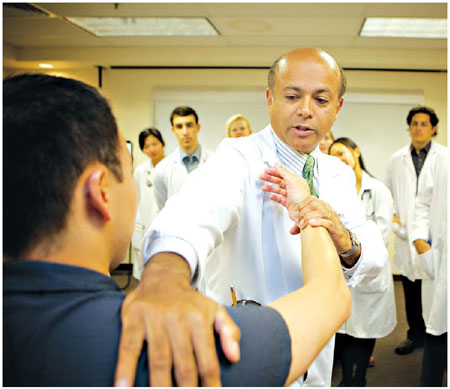A physician's crusade to revive physical exams
By Denise Grady (Agencies)
Updated: 2010-10-31 12:00
 |
Large Medium Small |
|
Dr. Abraham Verghese, an Indian raised in Ethiopia, says modern medicine relies too much on technology. Thor Swift for The New York Times |
STANFORD, California - Dr. Abraham Verghese is on a mission to bring back the physical exam. The touching, looking and listening were the once prized, almost magical skills of the doctor who could swiftly diagnose an ailment using just keen eyes, practiced hands and a stethoscope.
The senior associate chairman for the theory and practice of medicine at Stanford University, Dr. Verghese is also the author of two highly acclaimed memoirs, and a best'selling novel, "Cutting for Stone."
Art and medicine may seem disparate worlds, but Dr. Verghese, 55, insists that for him they are one.
He says his two careers have the same prerequisite: "infinite curiosity about other people."
"People are endlessly mysterious," he says.
Besides his medical degree, he has a writing degree from the University of Iowa.
The physical exam seems to be wasting away, he says, in an era of countless lab tests and too'brief doctor visits. Medical schools have let the exam slide, Dr. Verghese says. He jokes that a person could show up with a finger missing, and doctors would insist on an M.R.I., a CT scan and an orthopedic consult to confirm it.
Dr. Verghese trained in Ethiopia and India, where fancy equipment was scarce. He still believes a thorough exam can yield vital information and help doctors figure out which tests to order and which to skip. A proper exam also earns trust, he said, and serves as a ritual that transforms two strangers into doctor and patient.
His ideas have resonated with many doctors. With colleagues, he developed the Stanford 25, a list of techniques that every doctor should know, like how to listen to the heart or look at blood vessels at the back of the eye.
Making hospital rounds, Dr. Verghese is in his element, despite a painful back and knee. On a recent morning, he offered students questions, mini'lectures on science, and jokes.
Striding down the corridor, he told them about an unusual condition that produces silver'colored stools.
"You'll be so impressed you'll want to take them home," he said.
"Name five things that are better outside the body than in," he ordered, not mentioning that the answer appears in his novel: (answer: fluids, fetuses, foreign bodies, feces and flatus).
"You can't show up at the bedside and then turn on your skills," he said. "You have to keep your game sharp all the time."
Outside a patient's room, he had a group of interns and residents palpating their own thighs as he showed them exactly where to stick the needle when culturing an abscess.
"Wow!" said a student. "This is great."
Dr. Verghese smiled. "I am here to astound you," he said.
At times, he said, he feels almost embarrassed by all the interest in his work, because the techniques are the same ones he learned decades ago.
Born in Ethiopia, his Indian parents were teachers, and their expectations were high.
"You were a doctor, engineer, lawyer or a failure," he said.
He attended medical school in Addis Ababa, but after civil war broke out in Ethiopia in 1974 he joined his parents, who had moved to the United States several years earlier.
Living in New Jersey, he found he would have to start over, earning a bachelor's degree and then applying to medical schools, despite his two years of training.
He took a night job as a hospital orderly, spending time with co'workers after work. He says he lost his way during that period.
Then one night at work, he realized what he would be throwing away if he did not resume his training. He finished medical school in India, then did his residency in the United States.
He worked in Tennessee during the early days of the AIDS epidemic, before there were any effective treatments for the disease. Before AIDS, he said: "I must have been a conceited ass, full of knowledge. AIDS humbled a whole generation."
He came to know many of his patients, even attending their funerals. Once a patient, near death, awoke when Dr. Verghese arrived, and opened his shirt to be examined one last time.
"It was like an offering," Dr. Verghese said, with tears in his eyes. "To preside over the bed of a dying man in his last few hours. I listen, I thump, I don't even know what I'm listening for. But doing it says: ??��I will never leave you. I will not let you die in pain or alone.' There's not a test you can offer that does that."
The New York Times
